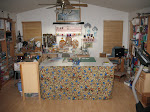Justice...
--
Posted By Donetta to A Life Uncommon at 12/25/2008 05:24:00 PM
Lost, Then Found: Herod’s Tomb
By Mike Nizza Herodium was built on the edge of the desert, south of Jerusalem. (Photo: Israeli Government Press Office, via Associated Press)
Herodium was built on the edge of the desert, south of Jerusalem. (Photo: Israeli Government Press Office, via Associated Press)For decades, archaeologists looking for the tomb of King Herod have focused on one site in particular, based on an account in the first volume of “The Wars of the Jews,” written by the first-century historian Flavius Josephus.
Josephus wrote that a 25-mile funeral procession for the Roman Empire’s man in Judea and the great builder of Jerusalem ended at “Herodium, where he had given order to be buried,” according to a translation at The Christian Classics Ethereal Library.
Instead of continuing about the procession’s final steps, and perhaps revealing further clues about the tomb’s location, the historian evidently considered the chapter done with the next sentence.
“And this shall suffice for the conclusion of the life of Herod,” he wrote.
 “It is something very special,” Professor Netzver said of Herod’s sarcophagus. (Photo: Menahem Kahana/AFP–Getty Images)
“It is something very special,” Professor Netzver said of Herod’s sarcophagus. (Photo: Menahem Kahana/AFP–Getty Images)The omission sets up what The Los Angeles Times has called “one of the Holy Land’s greatest archeological mysteries.”
Chasing that mystery and others for the past 35 years has been Professor Ehud Netzer of Hebrew University.
Today, he was finally able to announce an answer: The tomb was on the northeastern slope of Mount Herodium, a site that his team has been excavating since last summer.
Herodium, which Mr. Netzer called “the most outstanding among King Herod’s building projects,” may have been best described by Josephus in an earlier section of “the War of the Jews:”
And as he transmitted to eternity his family and friends, so did he not neglect a memorial for himself, but built a fortress upon a mountain towards Arabia, and named it from himself, Herodium, and he called that hill that was of the shape of a woman’s breast, and was sixty furlongs distant from Jerusalem, by the same name. He also bestowed much curious art upon it, with great ambition, and built round towers all about the top of it, and filled up the remaining space with the most costly palaces round about, insomuch that not only the sight of the inner apartments was splendid, but great wealth was laid out on the outward walls, and partitions, and roofs also. Besides this, he brought a mighty quantity of water from a great distance, and at vast charges, and raised an ascent to it of two hundred steps of the whitest marble, for the hill was itself moderately high, and entirely factitious. He also built other palaces about the roots of the hill, sufficient to receive the furniture that was put into them, with his friends also, insomuch that, on account of its containing all necessaries, the fortress might seem to be a city, but, by the bounds it had, a palace only.
The tomb had the same opulence, apparently, but it didn’t last very long.
The professor said that Jewish rebels trashed the place during the Great Revolt between the years 66 and 72 A.D., breaking Herod’s sarcophagus — made of rosetta-studded “Jerusalemite reddish limestone” — into “hundreds” of pieces.
Herodium, with the surviving ruins of a palace and fortress at the top of the mount, has at various times in history been colonized by monks and by lepers; it has been protected as a national park since the 1970s.













































































































No comments:
Post a Comment